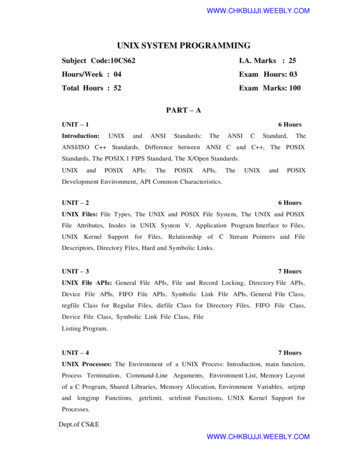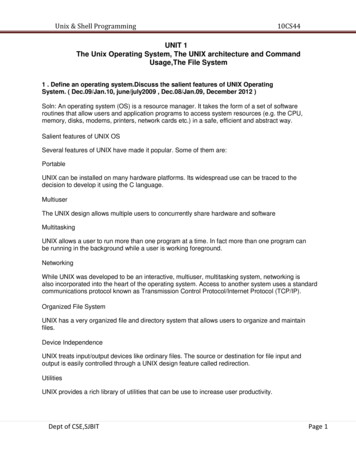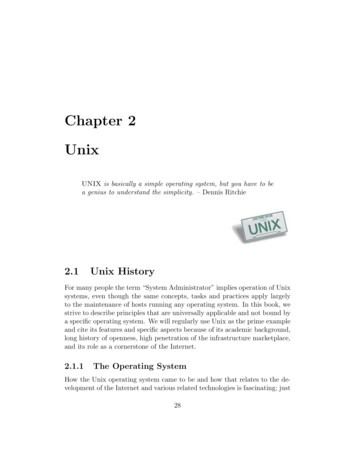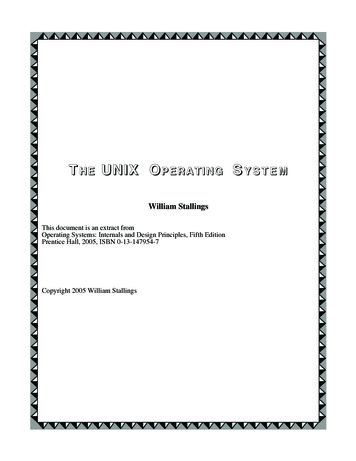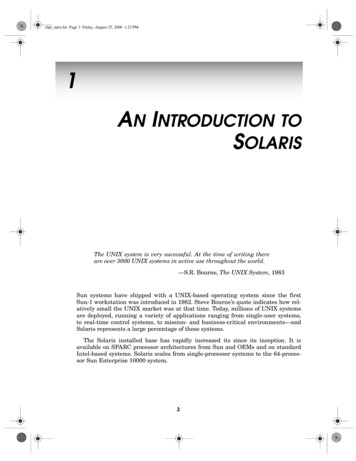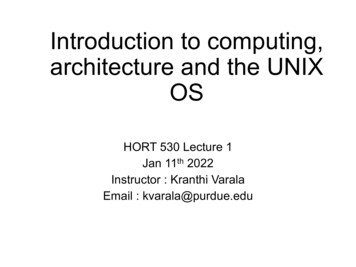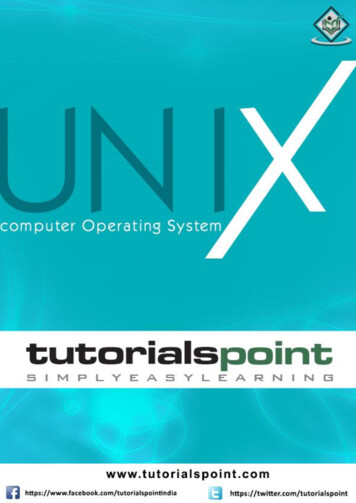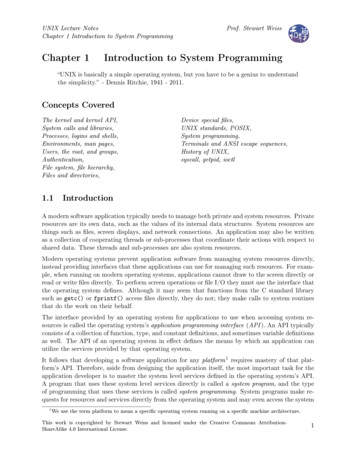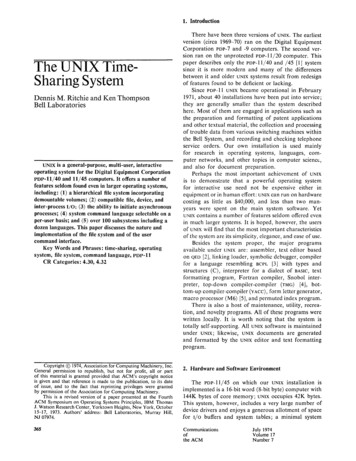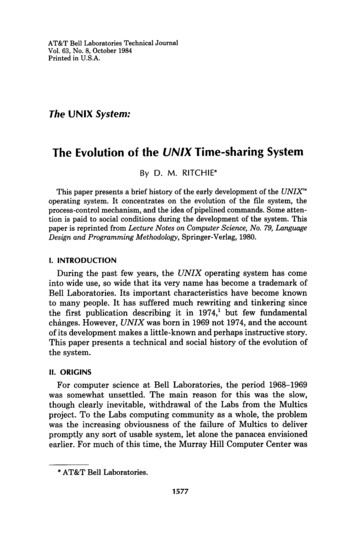
Transcription
AT&T Bell Laboratories Technical JournalVol. 63, No.8, October 1984Printed in U.S.A.The UNIX System:The Evolution of the UNIX Time-sharing SystemBy D. M. RITCHIE*This paper presents a brief history of the early development of the UNIX"'operating system. It concentrates on the evolution of the file system, theprocess-control mechanism, and the idea of pipelined commands. Some attention is paid to social conditions during the development of the system. Thispaper is reprinted from Lecture Notes on Computer Science, No. 79, LanguageDesign and Programming Methodology, Springer-Verlag, 1980.I. INTRODUCTIONDuring the past few years, the UNIX operating system has comeinto wide use, so wide that its very name has become a trademark ofBell Laboratories. Its important characteristics have become knownto many people. It has suffered much rewriting and tinkering sincethe first publication describing it in 1974,1 but few fundamentalchanges. However, UNIX was born in 1969 not 1974, and the accountof its development makes a little-known and perhaps instructive story.This paper presents a technical and social history of the evolution ofthe system.II. ORIGINSFor computer science at Bell Laboratories, the period 1968-1969was somewhat unsettled. The main reason for this was the slow,though clearly inevitable, withdrawal of the Labs from the Multicsproject. To the Labs computing community as a whole, the problemwas the increasing obviousness of the failure of Multics to deliverpromptly any sort of usable system, let alone the panacea envisionedearlier. For much of this time, the Murray Hill Computer Center was* AT&T Bell Laboratories.1577
also running a costly GE 645 machine that inadequately simulated theGE 635. Another shake-up that occurred during this period was theorganizational separation of computing services and computing research.From the point of view of the group that was to be most involved inthe beginnings of UNIX (K. Thompson, Ritchie, M. D. McIlroy, J. F.Ossanna), the decline and fall of Multics had a directly felt effect. Wewere among the last Bell Laboratories holdouts actually working onMultics, so we still felt some sort of stake in its success. Moreimportant, the convenient interactive computing service that Multicshad promised to the entire community was in fact available to ourlimited group, at first under the CTSS system used to develop Multics,and later under Multics itself. Even though Multics could not thensupport many users, it could support us, albeit at exorbitant cost. Wedidn't want to lose the pleasant niche we occupied, because no similarones were available; even the time-sharing service that would later beoffered under GE's operating system did not exist. What we wantedto preserve was not just a good environment in which to do programming, but a system around which a fellowship could form. We knewfrom experience that the essence of communal computing, as suppliedby remote-access, time-shared machines, is not just to type programsinto a terminal instead of a keypunch, but to encourage close communication.Thus, during 1969, we began trying to find an alternative to Multics.The search took several forms. Throughout 1969 we (mainly Ossanna,Thompson, Ritchie) lobbied intensively for the purchase of a mediumscale machine for which we promised to write an operating system;the machines we suggested were the DEC PDP-10 computer and theSDS (later Xerox) Sigma 7. The effort was frustrating, because ourproposals were never clearly and finally turned down, but yet werecertainly never accepted. Several times it seemed we were very nearsuccess. The final blow to this effort came when we presented anexquisitely complicated proposal, designed to minimize financial outlay, that involved some outright purchase, some third-party lease, anda plan to turn in a DEC KA-lO processor on the soon-to-be-announcedand more capable KI-lO. The proposal was rejected, and rumor soonhad it that W. O. Baker (then vice-president of Research) had reactedto it with the comment 'Bell Laboratories just doesn't do business thisway!'Actually, it is perfectly obvious in retrospect (and should have beenat the time) that we were asking the Labs to spend too much moneyon too few people with too vague a plan. Moreover, I am quite surethat at that time operating systems were not, for our management, anattractive area in which to support work. They were in the process of1578TECHNICAL JOURNAL, OCTOBER 1984
extricating themselves not only from an operating system developmenteffort that had failed, but from running the local Computation Center.Thus it may have seemed that buying a machine such as we suggestedmight lead on the one hand to yet another Multics, or on the other, ifwe produced something useful, to yet another Comp Center for themto be responsible for.Besides the financial agitations that took place in 1969, there wastechnical work also. Thompson, R. H. Canaday, and Ritchie developed,on blackboards and scribbled notes, the basic design of a file systemthat was later to become the heart of UNIX. Most of the design wasThompson's, as was the impulse to think about file systems at all, butI believe I contributed the idea of device files. Thompson's itch forcreation of an operating system took several forms during this period;he also wrote (on Multics) a fairly detailed simulation of the performance of the proposed file system design and of paging behavior ofprograms. In addition, he started work on a new operating system forthe GE 645, going as far as writing an assembler for the machine anda rudimentary operating system kernel whose greatest achievement,so far as I remember, was to type a greeting message. The complexityof the machine was such that a mere message was already a fairlynotable accomplishment, but when it became clear that the lifetime ofthe 645 at the Labs was measured in months, the work was dropped.Also during 1969, Thompson developed the game of 'Space Travel.'First written on Multics, then transliterated into Fortran for GECOS(the operating system for the GE, later Honeywell, 635), it was nothingless than a simulation of the movement of the major bodies of theSolar System, with the player guiding a ship here and there, observingthe scenery, and attempting to land on the various planets and moons.The GECOS version was unsatisfactory in two important respects:first, the display of the state of the game was jerky and hard to controlbecause one had to type commands at it, and second, a game costabout 75 for CPU time on the big computer. It did not take long,therefore, for Thompson to find a little-used PDP-7 computer with anexcellent display processor; the whole system was used as a GraphicII terminal. He and I rewrote Space Travel to run on this machine.The undertaking was more ambitious than it might seem; because wedisdained all existing software, we had to write a floating-point arithmetic package, the pointwise specification of the graphic charactersfor the display, and a debugging subsystem that continuously displayedthe contents of typed-in locations in a corner of the screen. All thiswas written in assembly language for a cross-assembler that ran underGECOS and produced paper tapes to be carried to the PDP-7.Space Travel, though it made a very attractive game, served mainlyas an introduction to the clumsy technology of preparing programs forTIME-SHARING1579
the PDP-7. Soon Thompson began implementing the paper file system(perhaps 'chalk file system' would be more accurate) that had beendesigned earlier. A file system without a way to exercise it is a sterileproposition, so he proceeded to flesh it out with the other requirementsfor a working operating system, in particular the notion of processes.Then came a small set of user-level utilities: the means to copy, print,delete, and edit files, and of course a simple command interpreter(shell). Up to this time all the programs were written using GECOSand files were transferred to the PDP-7 on paper tape; but once anassembler was completed the system was able to support itself. Although it was not until well into 1970 that Brian Kernighan suggestedthe name 'UNIX,' in a somewhat treacherous pun on 'Multics,' theoperating system we know today was born.III. THE PDP-7 UNIX FILE SYSTEMStructurally, the file system of PDP-7 UNIX was nearly identicalto today's. It had1. An i-list: a linear array of i-nodes each describing a file. An i-nodecontained less than it does now, but the essential information was thesame: the protection mode of the file, its type and size, and the list ofphysical blocks holding the contents.2. Directories: a special kind of file containing a sequence of namesand the associated i-number.3. Special files describing devices. The device specification was notcontained explicitly in the i-node, but was instead encoded in thenumber: specific i-numbers corresponded to specific files.The important file system calls were also present from the start.Read, write, open, creat (sic), close: with one very importantexception, discussed below, they were similar to what one finds now.A minor difference was that the unit of 10 was the word, not the byte,because the PDP-7 was a word-addressed machine. In practice thismeant merely that all programs dealing with character streams ignorednull characters, because null was used to pad a file to an even numberof characters. Another minor, occasionally annoying difference wasthe lack of erase and kill processing for terminals. Terminals, in effect,were always in raw mode. Only a few programs (notably the shell andthe editor) bothered to implement erase-kill processing.In spite of its considerable similarity to the current file system, thePDP-7 file system was in one way remarkably different: there were nopath names, and each file-name argument to the system was a simplename (without 'I') taken relative to the current directory. Links, inthe usual UNIX sense, did exist. Together with an elaborate set of1580TECHNICAL JOURNAL, OCTOBER 1984
conventions, they were the principal means by which the lack of pathnames became acceptable.Thecall took the formfile, newname)where dir was a directory file in the current directory, file an existingentry in that directory, and newname the name of the link, which wasadded to the current directory. Because dir needed to be in the currentdirectory, it is evident that today's prohibition against links to directories was not enforced; the PDP-7 UNIX file system had the shapeof a general directed graph.So that every user did not need to maintain a link to all directoriesof interest, there existed a directory called dd that contained entriesfor the directory of each user. Thus, to make a link to file x in directoryken, I might dolinklink (dir,In dd ken kenIn ken x xrm kenThis scheme rendered subdirectories sufficiently hard to use as tomake them unused in practice. Another important barrier was thatthere was no way to create a directory while the system was running;all were made during recreation of the file system from paper tape, sothat directories were in effect a nonrenewable resource.The dd convention made the chdir command relatively convenient. It took multiple arguments, and switched the current directoryto each named directory in turn. Thuschdir dd kenwould move to directory ken. (Incidentally, chdir was spelled ch;why this was expanded when we went to the PDP-ll I don't remember.)The most serious inconvenience of the implementation of the filesystem, aside from the lack of path names, was the difficulty ofchanging its configuration; as mentioned, directories and special fileswere both made only when the disk was recreated. Installation of anew device was very painful, because the code for devices was spreadwidely throughout the system; for example there were several loopsthat visited each device in turn. Not surprisingly, there was no notionof mounting a removable disk pack, because the machine had only asingle fixed-head disk.The operating system code that implemented this file system was adrastically simplified version of the present scheme. One importantsimplification followed from the fact that the system was not multiTIME-SHARING1581
programmed; only one program was in memory at a time, and controlwas passed between processes only when an explicit swap took place.So, for example, there was an iget routine that made a named i-nodeavailable, but it left the i-node in a constant, static location ratherthan returning a pointer into a large table of active i-nodes. A precursorof the current buffering mechanism was present (with about 4 buffers)but there was essentially no overlap of disk 10 with computation. Thiswas avoided not merely for simplicity. The disk attached to the PDP7 was fast for its time; it transferred one I8-bit word every 2 microseconds. On the other hand, the PDP-7 itself had a memory cycle timeof 1 microsecond, and most instructions took 2 cycles (one for theinstruction itself, one for the operand). However, indirectly addressedinstructions required 3 cycles, and indirection was quite common,because the machine had no index registers. Finally, the DMA controller was unable to access memory during an instruction. The upshotwas that the disk would incur overrun errors if any indirectly-addressed instructions were executed while it was transferring. Thuscontrol could not be returned to the user, nor in fact could generalsystem code be executed, with the disk running. The interrupt routinesfor the clock and terminals, which needed to be runnable at all times,had to be coded in very strange fashion to avoid indirection.IV. PROCESS CONTROLBy 'process control,' I mean the mechanisms by which processes arecreated and used; today the system calls fork, exec, wait, and exitimplement these mechanisms. Unlike the file system, which existedin nearly its present form from the earliest days, the process controlscheme underwent considerable mutation after PDP-7 UNIX wasalready in use. (The introduction of path names in the PDP-ll systemwas certainly a considerable notational advance, but not a change infundamental structure.)Today, the way in which commands are executed by the shell canbe summarized as follows:1. The shell reads a command line from the terminal.2. It creates a child process by fork.3. The child process uses exec to call in the command from a file.4. Meanwhile, the parent shell uses wait to wait for the child(command) process to terminate by calling exi t.5. The parent shell goes back to step 1.Processes (independently executing entities) existed very early inPDP-7 UNIX. There were in fact precisely two of them, one for eachof the two terminals attached to the machine. There was no fork,wait, or exec. There was an exit, but its meaning was ratherdifferent, as will be seen. The main loop of the shell went as follows.1582TECHNICAL JOURNAL, OCTOBER 1984
1. The shell closed all its open files, then opened the terminal specialfile for standard input and output (file descriptors 0 and 1).2. It read a command line from the terminal.3. It linked to the file specifying the command, opened the file, andremoved the link. Then it copied a small bootstrap program to the topof memory and jumped to it; this bootstrap program read in the fileover the shell code, then jumped to the first location of the command(in effect an exec).4. The command did its work, then terminated by calling exi t. Theex i t call caused the system to read in a fresh copy of the shell overthe terminated command, then to jump to its start (and thus in effectto go to step 1).The most interesting thing about this primitive implementation isthe degree to which it anticipated themes developed more fully later.True, it could support neither background processes nor shell command files (let alone pipes and filters); but 10 redirection (via ' ' andI ') was soon there; it is discussed below. The implementation ofredirection was quite straightforward; in step 3 above the shell justreplaced its standard input or output with the appropriate file. Crucialto subsequent development was the implementation of the shell as auser-level program stored in a file, rather than a part of the operatingsystem.The structure of this process control scheme, with one process perterminal, is similar to that of many interactive systems, for exampleCTSS, Multics, Honeywell TSS, and IBM TSS and TSO. In generalsuch systems require special mechanisms to implement useful facilitiessuch as detached computations and command files; UNIX at thatstage didn't bother to supply the special mechanisms. It also exhibitedsome irritating, idiosyncratic problems. For example, a newly recreatedshell had to close all its open files both to get rid of any open files leftby the command just executed and to rescind previous 10 redirection.Then it had to reopen the special file corresponding to its terminal, inorder to read a new command line. There was no /dev directory(because no path names); moreover, the shell could retain no memoryacross commands, because it was reexecuted afresh after each command. Thus a further file system convention was required: eachdirectory had to contain an entry tty for a special file that referredto the terminal of the process that opened it. If by accident onechanged into some directory that lacked this entry, the shell wouldloop hopelessly; about the only remedy was to reboot. (Sometimes themissing link could be made from the other terminal.)Process control in its modern form was designed and implementedwithin a couple of days. It is astonishing how easily it fitted into theexisting system; at the same time it is easy to see how some of theTIME-SHARING1583
slightly unusual features of the design are present precisely becausethey represented small, easily-coded changes to what existed. A goodexample is the separation of the fork and exec functions. The mostcommon model for the creation of new processes involves specifying aprogram for the process to execute; in UNIX, a forked process continues to run the same program as its parent until it performs an explicitexec. The separation of the functions is certainly not unique to UNIX,and in fact it was present in the Berkeley time-sharing system," whichwas well-known to Thompson. Still, it seems reasonable to supposethat it exists in UNIX, mainly because of the ease with which forkcould be implemented without changing much else. The system alreadyhandled multiple (i.e, two) processes; there was a process table, andthe processes were swapped between main memory and the disk. Theinitial implementation of fork required only1. Expansion of the process table2. Addition of a fork call that copied the current process to the diskswap area, using the already existing swap 10 primitives, and madesome adjustments to the process table.In fact, the PDP-7's fork call required precisely 27 lines of assemblycode. Of course, other changes in the operating system and userprograms were required, and some of them were rather interesting andunexpected. But a combined fork-exec would have been considerablymore complicated, if only because exec as such did not exist; itsfunction was already performed, using explicit 10, by the shell.The exit system call, which previously read in a new copy of theshell (actually a sort of automatic exec but without arguments),simplified considerably; in the new version a process only had to cleanout its process table entry and give up control.Curiously, the primitives that became wai t were considerably moregeneral than the present scheme. A pair of primitives sent one-wordmessages between named processes:smes(pid, message)(pid, message) rmes()The target process of smes did not need to have any ancestral relationship with the receiver, although the system provided no explicitmechanism for communicating process IDs except that fork returnedto each of the parent and child the ID of its relative. Messages werenot queued; a sender delayed until the receiver read the message.The message facility was used as follows: the parent shell, aftercreating a process to execute a command, sent a message to the newprocess by smes; when the command terminated (assuming it did nottry to read any messages) the shell's blocked smes call returned anerror indication that the target process did not exist. Thus the shell's1584TECHNICAL JOURNAL, OCTOBER 1984
smes became, in effect, the equivalent of wai t.A different protocol, which took advantage of more of the generalityoffered by messages, was used between the initialization program andthe shells for each terminal. The initialization process, whose ID wasunderstood to be 1, created a shell for each of the terminals, and thenissued rmes; each shell, when it read the end of its input file, usedsmes to send a conventional 'I am terminating' message to the initialization process, which recreated a new shell process for that terminal.I can recall no other use of messages. This explains why the facilitywas replaced by the wait call of the present system, which is lessgeneral, but more directly applicable to the desired purpose. Possiblyrelevant also is the evident bug in the mechanism: if a commandprocess attempted to use messages to communicate with other processes, it would disrupt the shell's synchronization. The shell dependedon sending a message that was never received; if a command executedrmes, it would receive the shell's phony message, and cause the shellto read another input line just as if the command had terminated. Ifa need for general messages had manifested itself, the bug would havebeen repaired.At any rate, the new process control scheme instantly renderedsome very valuable features trivial to implement; for example, detached processes (with '&') and recursive use of the shell as a command. Most systems have to supply some sort of special 'batch jobsubmission' facility and a special command interpreter for files distinctfrom the one used interactively.Although the multiple-process idea slipped in very easily indeed,there were some aftereffects that weren't anticipated. The most memorable of these became evident soon after the new system came upand apparently worked. In the midst of our jubilation, it was discoveredthat the ehdir (change current directory) command had stoppedworking. There was much reading of code and anxious introspectionabout how the addition of fork could have broken the ehdir call.Finally the truth dawned; in the old system ehdir was an ordinarycommand; it adjusted the current directory of the (unique) processattached to the terminal. Under the new system, the ehdir commandcorrectly changed the current directory of the process created toexecute it, but this process promptly terminated and had no effectwhatsoever on its parent shell! It was necessary to make ehdir aspecial command, executed internally within the shell. It turns outthat several command-like functions have the same property, forexample login.Another mismatch between the system as it had been and the newprocess control scheme took longer to become evident. Originally, theread/write pointer associated with each open file was stored withinTIME-SHARING1585
the process that opened the file. (This pointer indicates where in thefile the next read or write will take place.) The problem with thisorganization became evident only when we tried to use command files.Suppose a simple command file containslswhoand it is executed as follows:sh comfi1e outputThe sequence of events was1. The main shell creates a new process, which opens outf ile toreceive the standard output and executes the shell recursively.2. The new shell creates another process to execute ls, whichcorrectly writes on file output and then terminates.3. Another process is created to execute the next command. However, the 10 pointer for the output is copied from that of the shell,and it is still 0, because the shell has never written on its output, and10 pointers are associated with processes. The effect is that the outputof who overwrites and destroys the output of the preceding ls command.Solution of this problem required creation of a new system table tocontain the 10 pointers of open files independently of the process inwhich they were opened.V. 10 REDIRECTIONThe very convenient notation for 10 redirection, using the ' ' and' ' characters, was not present from the very beginning of thePDP-7 UNIX system, but it did appear quite early. Like much else inUNIX, it was inspired by an idea from Multics. Multics has a rathergeneral 10 redirection mechanism" embodying named 10 streams thatcan be dynamically redirected to various devices, files, and eventhrough special stream-processing modules. Even in version of Multicswe were familiar with a decade ago, there existed a command thatswitched subsequent output normally destined for the terminal to afile, and another command to reattach output to the terminal. Whereunder UNIX one might sayls xxto get a listing of the names of one's files in xx, on Multics the notationwas1586TECHNICAL JOURNAL, OCTOBER 1984
iocall attach user output file xxlistiocall attach user output syn user i/oEven though this very clumsy sequence was used often during theMultics days, and would have been utterly straightforward to integrateinto the Multics shell, the idea did not occur to us or anyone else atthe time. I speculate that the reason it did not was the sheer size ofthe Multics project: the implementors of the 10 system were at BellLabs in Murray Hill, while the shell was done at MIT. We didn'tconsider making changes to the shell (it was their program); correspondingly, the keepers of the shell may not even have known of theusefulness, albeit clumsiness, of iocall. (The 1969 Multics manual"lists iocall as an 'author-maintained,' that is non-standard, command.) Because both the UNIX 10 system and its shell were underthe exclusive control of Thompson, when the right idea finally surfaced, it was a matter of an hour or so to implement it.VI. THE ADVENT OF THE PDP-11By the beginning of 1970, PDP-7 UNIX was a going concern.Primitive by today's standards, it was still capable of providing a morecongenial programming environment than its alternatives. Nevertheless, it was clear that the PDP-7, a machine we didn't even own, wasalready obsolete, and its successors in the same line offered little ofinterest. In early 1970 we proposed acquisition of a PDP-ll, whichhad just been introduced by Digital. In some sense, this proposal wasmerely the latest in the series of attempts that had been madethroughout the preceding year. It differed in two important ways.First, the amount of money (about 65,000) was an order of magnitudeless than what we had previously asked; second, the charter soughtwas not merely to write some (unspecified) operating system, butinstead to create a system specifically designed for editing and formatting text, what might today be called a 'word-processing system.'The impetus for the proposal came mainly from J. F. Ossanna, whowas then and until the end of his life interested in text processing. Ifour early proposals were too vague, this one was perhaps too specific;at first it too met with disfavor. Before long, however, funds wereobtained through the efforts of L. E. McMahon and an order for aPDP-ll was placed in May.The processor arrived at the end of the summer, but the PDP-llwas so new a product that no disk was available until December. Inthe meantime, a rudimentary, core-only version of UNIX was writtenusing a cross-assembler on the PDP-7. Most of the time, the machineTIME-SHARING1587
sat in a corner, enumerating all the closed Knight's tours on a 6 x 8chess board-a three-month job.VII. THE FIRST PDP-11 SYSTEMOnce the disk arrived, the system was quickly completed. In internalstructure, the first version of UNIX for the PDP-ll represented arelatively minor advance over the PDP-7 system; writing it was largelya matter of transliteration. For example, there was no multiprogramming; only one user program was present in core at any moment. Onthe other hand, there were important changes in the interface to theuser: the present directory structure, with full path names, was inplace, along with the modern form of exec and wa i t, and convenienceslike character-erase and line-kill processing for terminals. Perhaps themost interesting thing about the enterprise was its small size: therewere 24K bytes of core memory (16K for the system, 8K for userprograms), and a disk with 1K blocks (512K bytes). Files were limitedto 64K bytes.At the time of the placement of the order for the PDP-ll, it hadseemed natural, or perhaps expedient, to promise a system dedicatedto word processing. During the protracted arrival of the hardware, theincreasing usefulness of PDP-7 UNIX made it appropriate to justifycreating PDP-ll UNIX as a development tool, to be used in writingthe more special-purpose system. By the spring of 1971, it was generally agreed that no one had the slightest interest in scrapping UNIX.Therefore, we transliterated the roff text formatter into PDP-llassembler language, starting from the PDP-7 version that had beentransliterated from McIlroy's BCPL version on Multics, which had inturn been inspired by J. Saltzer's runoff program on CTSS. In earlysummer, editor and formatter in hand, we felt prepared to fulfill ourcharter by offering to supply a text-processing service to our Patentdepartment for preparing patent applications. At the time, they wereevaluating a commercial system for this purpose; the main advantageswe offered (besides the dubious one of taking part in an in-houseexperiment) were two in number: first, we supported Teletype's model37 terminals, which, with an extended type-box, could print most ofthe math symbols they required; second, we quickly endowed roffwith the ability to produce line-numbered pages, which the Patentdepartment required and which the other system could not handle.During the last half of 1971, we su
the name 'UNIX,' in a somewhat treacherous pun on 'Multics,' the operating system we know today was born. III. THE PDP-7 UNIX FILE SYSTEM Structurally, the file system of PDP-7 UNIX was nearly identical to today's. Ithad 1. An i-list: a linear array of i-nodes each describing a file. An i-n
